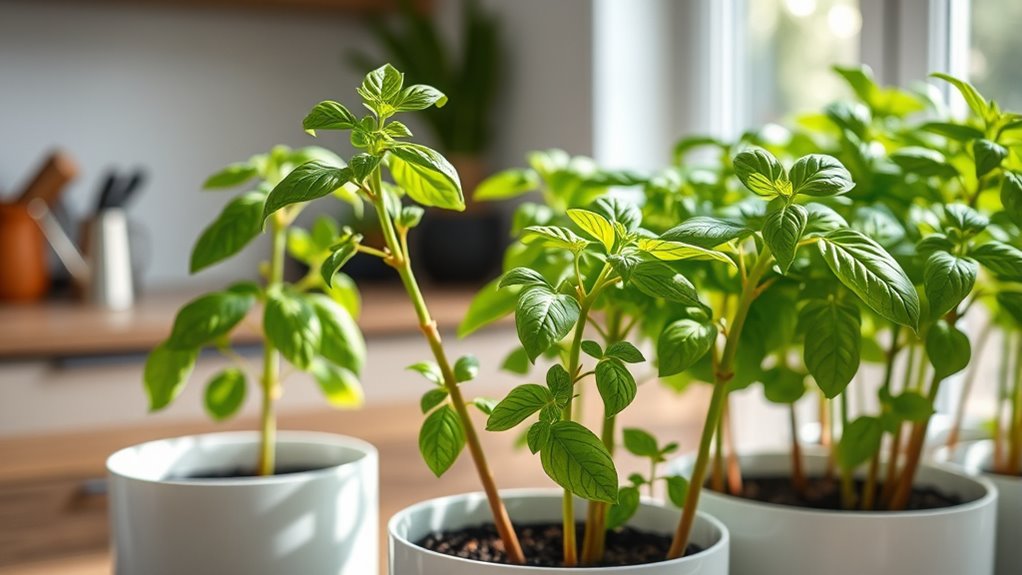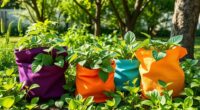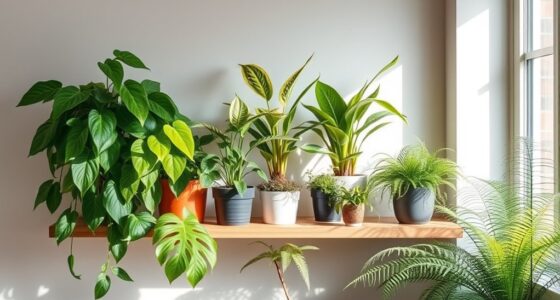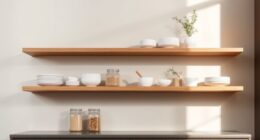To grow basil indoors successfully, choose containers with drainage holes and fill them with high-quality, well-draining potting mix enriched with compost. Provide 6-8 hours of bright light daily, maintain temperatures above 70°F, and guarantee good air circulation. Water when the top inch of soil feels dry, and fertilize lightly every few weeks. Regular pruning encourages bushiness, and proper harvesting improves flavor. For more tips on nurturing your indoor basil, continue exploring this guide.
Key Takeaways
- Provide 6-8 hours of bright, direct light daily using grow lights or south-facing windows.
- Use well-draining potting mix enriched with organic compost and perlite or coarse sand.
- Water when the top inch of soil is dry, and fertilize with half-strength liquid fertilizer every 4 weeks.
- Maintain indoor temperatures above 70°F, avoid cold drafts, and ensure good air circulation.
- Regularly prune and harvest basil to promote bushiness, prevent flowering, and enhance leaf flavor.
Selecting the Perfect Container and Soil for Indoor Basil

To guarantee your indoor basil thrives, start by choosing a container with drainage holes at least 4 inches in diameter. This prevents water from accumulating, ensuring healthy root development. Select a high-quality, well-draining potting mix enriched with organic compost to provide essential nutrients and retain moisture without becoming waterlogged. To improve drainage and aeration, mix in perlite or coarse sand, which reduces the risk of root rot. As your basil grows, transplant it into larger containers, typically from 4-inch pots to 8-12 inch ones. Incorporate self watering plant pots to help maintain consistent moisture levels and reduce the frequency of watering, especially in indoor environments. Avoid using garden soil directly, as it can compact and hinder drainage. Instead, focus on a container that promotes proper water flow and a soil mix that supports healthy, vigorous growth for your indoor basil. Additionally, choosing appropriate watering techniques can further enhance plant health and prevent overwatering or underwatering.
Optimal Lighting, Temperature, and Humidity Conditions

Providing your indoor basil with the right lighting, temperature, and humidity is essential for healthy growth. Aim for at least 6-8 hours of bright light daily, using grow lights or a south-facing window to guarantee your indoor basil gets enough light.
Keep the temperature at or above 70°F; anything below 50°F can cause leaf blackening and damage. Consistent air circulation helps prevent fungal issues and promotes plant health.
Moderate humidity levels are ideal; if the air is dry, occasional misting can help, but avoid excessive humidity to prevent mold. Proper environmental control is crucial for thriving indoor basil. Additionally, monitoring humidity levels regularly can help you make adjustments to keep your basil thriving.
Incorporating professional equipment such as hygrometers can ensure precise humidity management, leading to healthier plants. During hot summer days, providing some shade during peak sunlight hours prevents overheating and wilting. Maintaining these ideal conditions will foster vigorous, healthy basil plants indoors, especially since proper humidity regulation can significantly influence plant vitality.
Watering, Fertilizing, and Regular Pruning Techniques
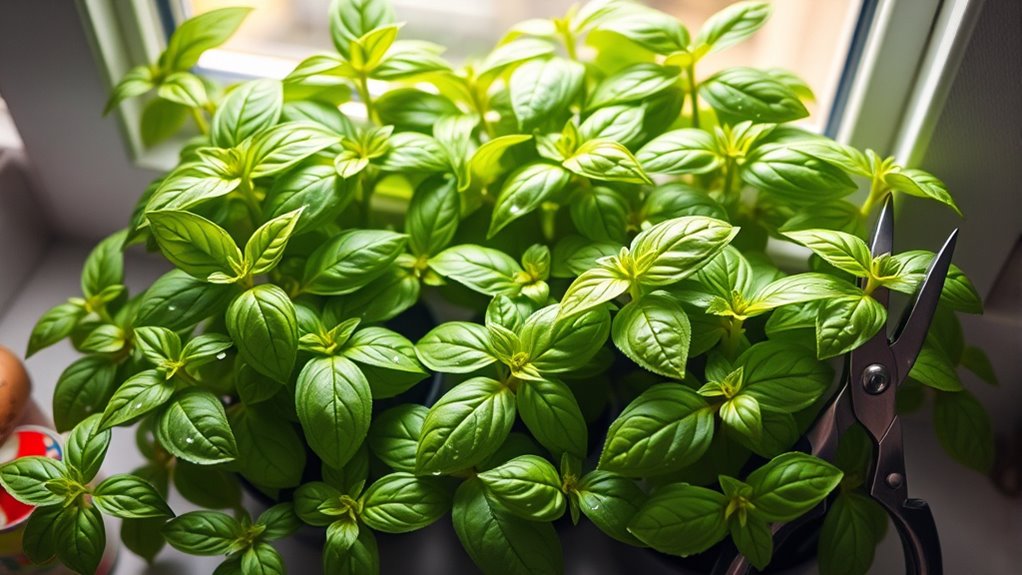
Proper watering, fertilizing, and pruning are key to keeping your indoor basil healthy and productive. To maintain ideal soil moisture, water your basil when the top inch of soil feels dry, usually every 1-2 days. Use a balanced, half-strength liquid fertilizer every 4 weeks during the growing season to support healthy growth. Regular pruning encourages bushier plants and prevents flowering, which can divert energy from leaf production. Remove yellow or dead leaves promptly to improve air circulation and reduce disease risk. Additionally, trim flowering stems as soon as they appear to prolong the plant’s productivity. Unique and Wicked Planters can also serve as attractive containers for your basil, enhancing your indoor gardening experience. Consistent care is essential for a thriving herb, and paying attention to the plant’s specific needs will ensure a lush, flavorful harvest. Incorporating Vetted electric bike conversion kits can be a fun way to explore urban environments while tending your garden, demonstrating how versatile and adaptable your hobbies can be.
Transplanting and Moving Basil Outdoors for the Summer
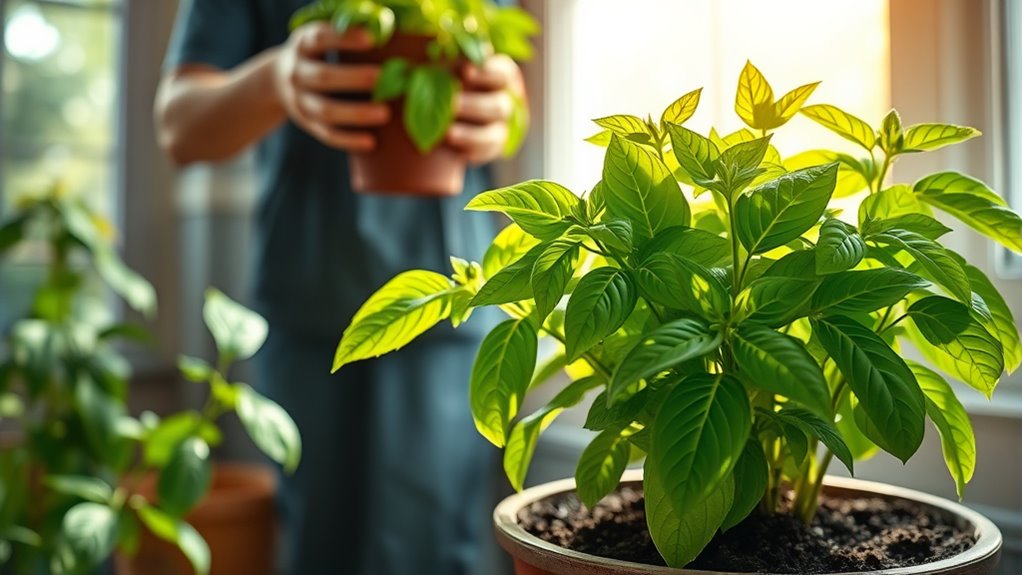
Transplanting basil outdoors requires timing and preparation to guarantee a smooth progression from indoor to outdoor growth. Wait until nighttime temperatures stay above 50°F to avoid damaging cold.
Before transplanting basil outdoors, harden off basil by gradually exposing it to outdoor conditions over a week, starting with a few hours daily.
Choose a sunny, well-drained outdoor basil location with at least 6-8 hours of direct sunlight.
When doing a summer basil transplant, space basil plants about 12-16 inches apart to promote airflow and reduce disease risk.
Water basil outdoors thoroughly after transplanting and apply a light mulch to conserve moisture and suppress weeds. Also, incorporating sound healing science techniques, such as gentle vibrations around your garden, can promote plant health and growth.
Proper outdoor basil care and protecting basil from cold are essential for successful seasonal basil planting. Understanding how to protect your basil from unexpected cold snaps can help ensure a thriving summer crop.
Harvesting, Propagation, and Troubleshooting Common Issues

To keep your basil thriving, it’s essential to master harvesting, propagation, and troubleshooting common issues.
Proper harvesting involves snipping stems just above two large leaves, removing no more than one-third of the plant to encourage continuous growth.
For propagation, stem cuttings with at least one or two nodes root easily in water or soil. Ensuring proper root development is key to successful propagation.
Regular pruning prevents flowering, which can diminish leaf flavor and oil content. Utilizing crochet techniques can also be helpful for crafting supportive or decorative plant accessories, promoting a healthy environment for your basil.
Troubleshoot common issues like yellowing leaves caused by overwatering or pests such as aphids and spider mites by inspecting leaves and applying organic controls. Recognizing signs of plant stress can help you address problems early and keep your basil healthy.
Guarantee your plant receives adequate light, proper watering, and consistent pruning for ideal plant care.
Additionally, being aware of environmental impacts, such as air pollution from nearby sources, can help you optimize your indoor conditions to promote healthier plant growth.
Frequently Asked Questions
How Do You Grow Basil Indoors Successfully?
To grow basil indoors successfully, place it in a south-facing window or under grow lights that give at least 6 hours of direct sunlight daily. Use well-draining, nutrient-rich soil, and keep it consistently moist by watering when the top inch feels dry.
Maintain indoor temperatures around 70°F, prune regularly to encourage bushiness, and fertilize monthly with a diluted organic fertilizer to promote healthy, vigorous growth.
What Is the Trick to Growing Basil?
Imagine basil as a sun-loving artist, needing just the right light to paint its vibrant leaves. The trick? Provide at least 6 hours of direct sunlight or high-quality grow lights.
Keep temperatures around 70°F, and maintain consistent moisture. Regular pruning and removing flower buds focus energy on leaf growth, turning your plant into a lush, flavorful masterpiece.
Follow these steps, and your basil will thrive indoors.
How to Pick Basil so It Keeps Growing Indoors?
When picking basil, choose healthy plants with vibrant green leaves and no signs of pests or disease.
Use sharp scissors or your fingers to pinch stems above two leaves, encouraging bushier growth and preventing flowering.
Regularly harvest by removing the top stems, and always pick gently to avoid damaging the plant.
This way, you’ll keep your basil thriving indoors, ensuring continuous, lush foliage for your culinary needs.
Can You Keep Basil Indoors All Year?
You can keep basil indoors all year if you give it the right conditions. Imagine a homeowner who maintains a consistent 70°F temperature, uses grow lights during winter, and prunes regularly.
With proper watering, humidity, and pest control, your basil can thrive beyond six months. By mimicking outdoor conditions indoors, you’ll enjoy fresh basil year-round, ensuring continuous harvests and vibrant growth.
Conclusion
Growing basil indoors is rewarding and easy with the right care. Did you know that basil can boost indoor air quality by filtering out toxins? By selecting the right container, providing ample light, and maintaining proper watering and pruning, you’ll enjoy fresh herbs year-round. Remember, basil is a fast grower—often ready to harvest in just a few weeks—so stay attentive, troubleshoot issues early, and you’ll enjoy abundant, aromatic leaves anytime you like.
